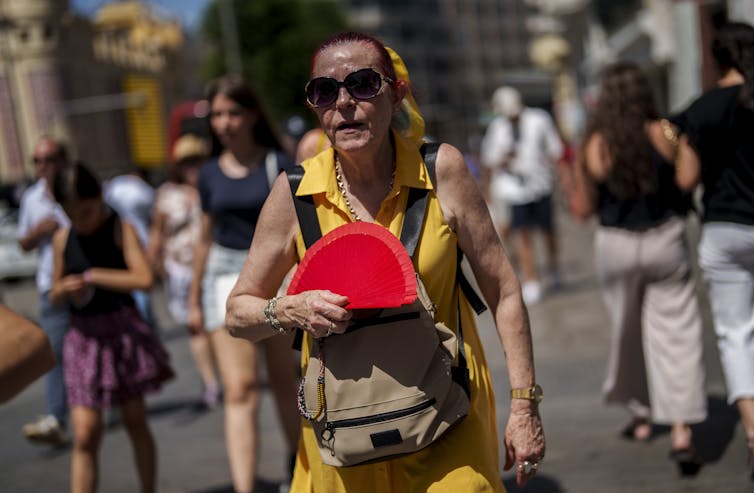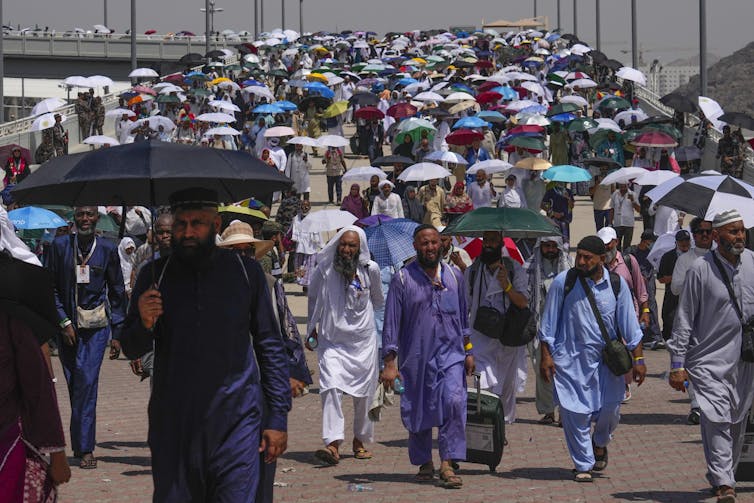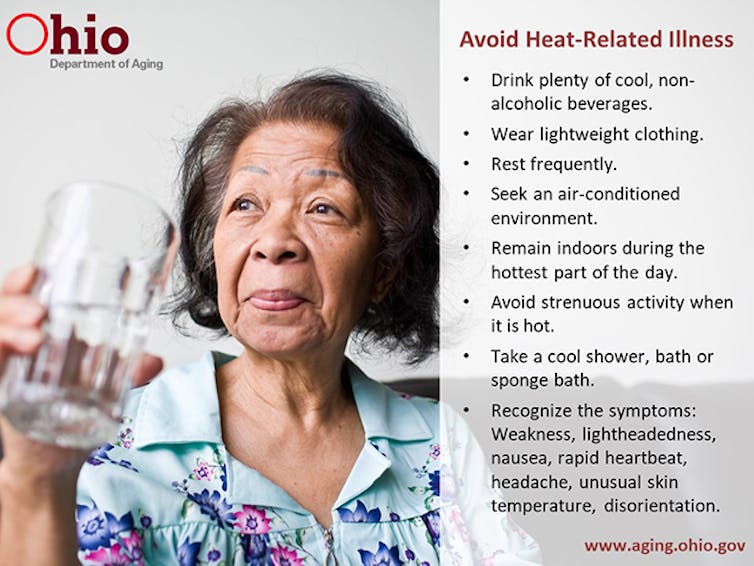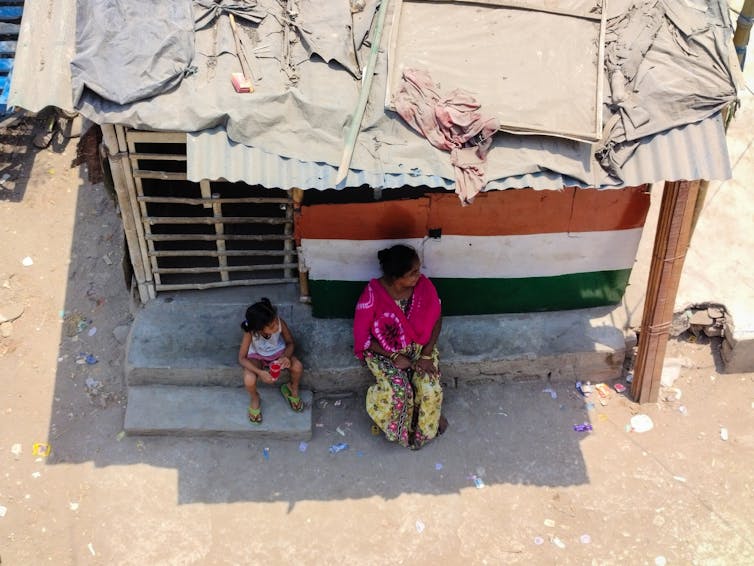
 Editor's note: As part of United Methodist Insight's coverage of Climate Week in New York City, we republish this article from The Conversation on the dangers of heat for older people. The average age of United Methodists is now 57, and rising, so extreme heat forms a concern for the church as well as the general public. Insight participates in the global collaboration Covering Climate Now.
Editor's note: As part of United Methodist Insight's coverage of Climate Week in New York City, we republish this article from The Conversation on the dangers of heat for older people. The average age of United Methodists is now 57, and rising, so extreme heat forms a concern for the church as well as the general public. Insight participates in the global collaboration Covering Climate Now.
Deborah Carr, Boston University; Enrica De Cian, Ca' Foscari University of Venice; Giacomo Falchetta, Ca' Foscari University of Venice, and Ian Sue Wing, Boston University
A deadly heat wave gripped Asia for weeks in spring 2024, sending temperatures in India’s capital region over 120 degrees Fahrenheit (49 Celsius) in May. Campaigning politicians, news announcers and Indian voters waiting in long lines passed out in the oppressive heat.
In June, hundreds of people on the Hajj, a Muslim pilgrimage to Mecca, Saudi Arabia, died in searing heat that reached 120 F (49 C) with high humidity.
Most of the planet has suffered the dire effects of extreme heat in recent years. Phoenix hit 110 F (43.3 C) or higher for 31 straight days in summer 2023, and Europe saw unprecedented heat that killed hundreds and contributed to devastating wildfires in Greece. Mexico and neighboring regions were sweltering through a dangerous and long-running heat wave in 2024.
Regardless of where or when a heat wave strikes, one pattern has been a constant: Older adults are the most likely to die from extreme heat, and the crisis is worsening.

We study climate change and population aging. Our research documents two global trends that together portend a dire future.
More older adults will be at risk of heat stress
First, temperatures are hotter than ever. The nine-year period from 2015 and 2023 had the highest average temperatures since global records began in 1880.
Second, the population is aging worldwide. By 2050, the number of people ages 60 and older will double to nearly 2.1 billion, making up 21% of the global population. That proportion is 13% today.
These combined forces mean that ever-rising numbers of vulnerable older adults will be exposed to intensifying heat.

To understand the risks ahead, we developed population projections for different age groups and combined them with climate change scenarios for the coming decades. Our analyses show that by 2050, more than 23% of the world population ages 69 and older will be living in regions where peak temperatures routinely surpass 99.5°F (37.5°C), compared with just 14% today.
That means that as many as 250 million additional older adults will be exposed to dangerously high temperatures.
Mapping the data shows that most of these older adults live in lower- and middle-income countries with insufficient services and limited access to electricity, cooling appliances and safe water.
In historically cooler regions in the Global North, including North America and Europe, rising temperatures will be the main force driving older adults’ heat exposure. In historically hotter regions in the Global South such as Asia, Africa and South America, population growth and increases in longevity mean that steeply rising numbers of older adults will be exposed to intensifying heat-related risks.
Policymakers, communities, families and older residents themselves need to understand these risks and be prepared because of older adults’ special vulnerabilities to heat.
Extreme heat is especially harmful to older adults
High temperatures are oppressive for everyone, but for older adults they can be deadly.
Extreme heat worsens common age-related health conditions such as heart, lung and kidney disease and can cause delirium. Older people don’t sweat as much as younger people, which makes it harder for their bodies to cool down when temperatures spike. These problems are intensified by common prescription medications, such as anticholinergics, which further reduce the capacity to sweat.
Spending time outdoors in hot humid weather can cause dehydration, a problem worsened by the side effects of prescription medications such as diuretics and beta-blockers. Dehydration can make older adults weak and dizzy, increasing their risk of falls and injury. These threats are even worse in regions lacking access to safe and affordable drinking water.

Poor air quality makes it difficult to breath, especially for those who already have lung problems such as chronic obstructive pulmonary disease, or COPD.
For older adults with physical health problems, temperatures as low as 80 F (26.7 C) can pose significant danger. And when humidity is as high as 90%, even 78 F (25.6 C) can be hazardous to older adults.
Nighttime heat is especially harmful for older adults whose homes lack air conditioning or who can’t afford to run their air conditioners for long periods. The ideal temperature for older adults’ restful sleep is between 68 and 77 F (20 and 25 C), and sleep quality diminishes as temperatures rise. A night of restless sleep can make an older adult more depressed and confused during their waking hours. Medications also can lose their effectiveness if stored in places much warmer than 77 F (25 C).
Older adults also may suffer emotionally during stifling heat waves
Being stuck indoors when temperatures are unbearable can make older adults bored, depressed and isolated. People with cognitive impairments may underestimate the dangers of extreme heat or may not understand the heat advisories.
Those who have physical mobility limitations or lack access to transportation can’t easily travel to public cooling centers – if there is one nearby – or find relief in nearby “green and blue areas,” such as parks and lakes.
These threats are especially dire in low- and middle-income nations, where older adults are more likely to live in substandard housing and lack access to high-quality health care or ways to cool down in the heat. We talk about this as “systemic cooling poverty.”
What can be done?
Policymakers can work to cut greenhouse gas emissions from fossil fuels in vehicles, power plants and factories, which drive global warming, and develop effective plans to protect older people from heat risk. Older adults and their caregivers also can take steps to adapt.
But efforts to help need to be tailored to each region and population.
Wealthy municipalities can increase public investments in early warning systems and ride services to cooling centers and hospitals. They can use geographic information systems to identify neighborhoods with high concentrations of older adults and expand power grids to manage increasing demand for air conditioning.

In regions with substandard housing, limited access to clean water and few public supports such as cooling centers, much larger changes are necessary. Providing better health care, water and housing and reducing air pollution that can mitigate health problems during heat waves require significant changes and investments many countries struggle to afford.
The World Health Organization and Pan American Health Organization warn that this decade will be critical for preparing communities to handle rising heat and the risk to aging populations. Across all regions, researchers, practitioners and policymakers could save lives by heeding their call.
This article, originally published May 22, 2024, has been updated with deaths during the Hajj.![]()
Deborah Carr, A&S Distinguished Professor of Sociology and Director of the Center for Innovation in Social Science, Boston University; Enrica De Cian, Professor of Environmental Economics, Ca' Foscari University of Venice; Giacomo Falchetta, Research Scholar in Energy, Climate and Environment, Ca' Foscari University of Venice, and Ian Sue Wing, Professor of Earth and Environment, Boston University
This article is republished from The Conversation under a Creative Commons license. Read the original article.
